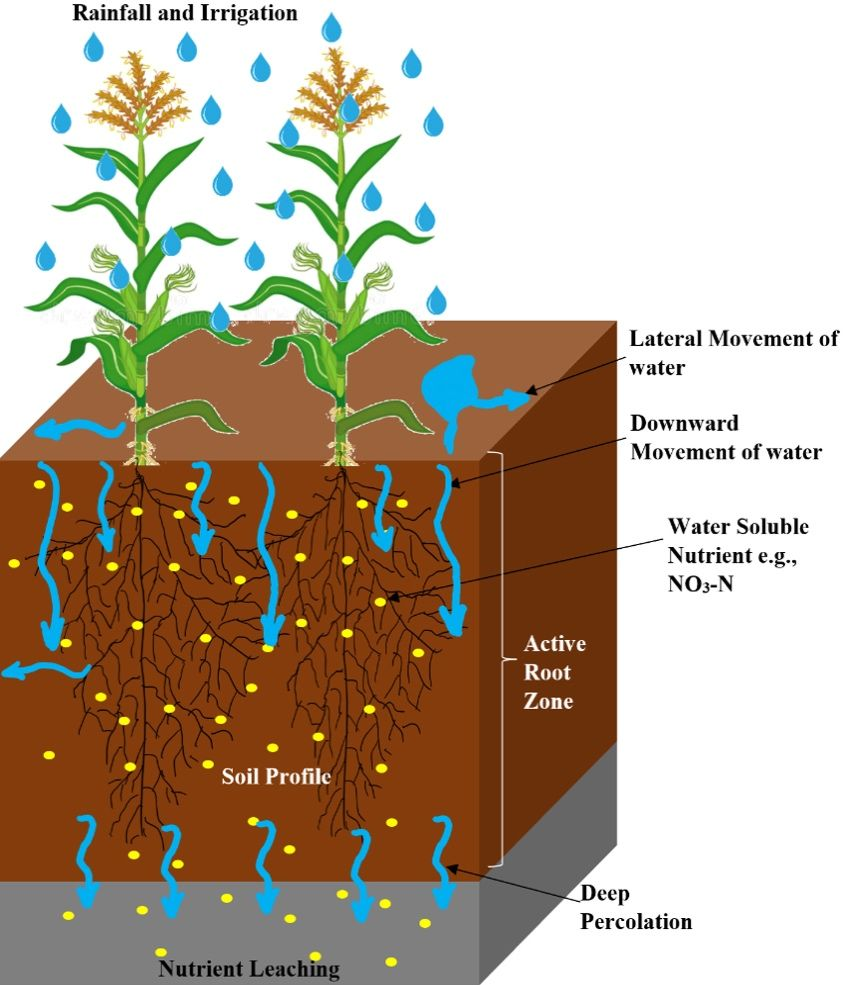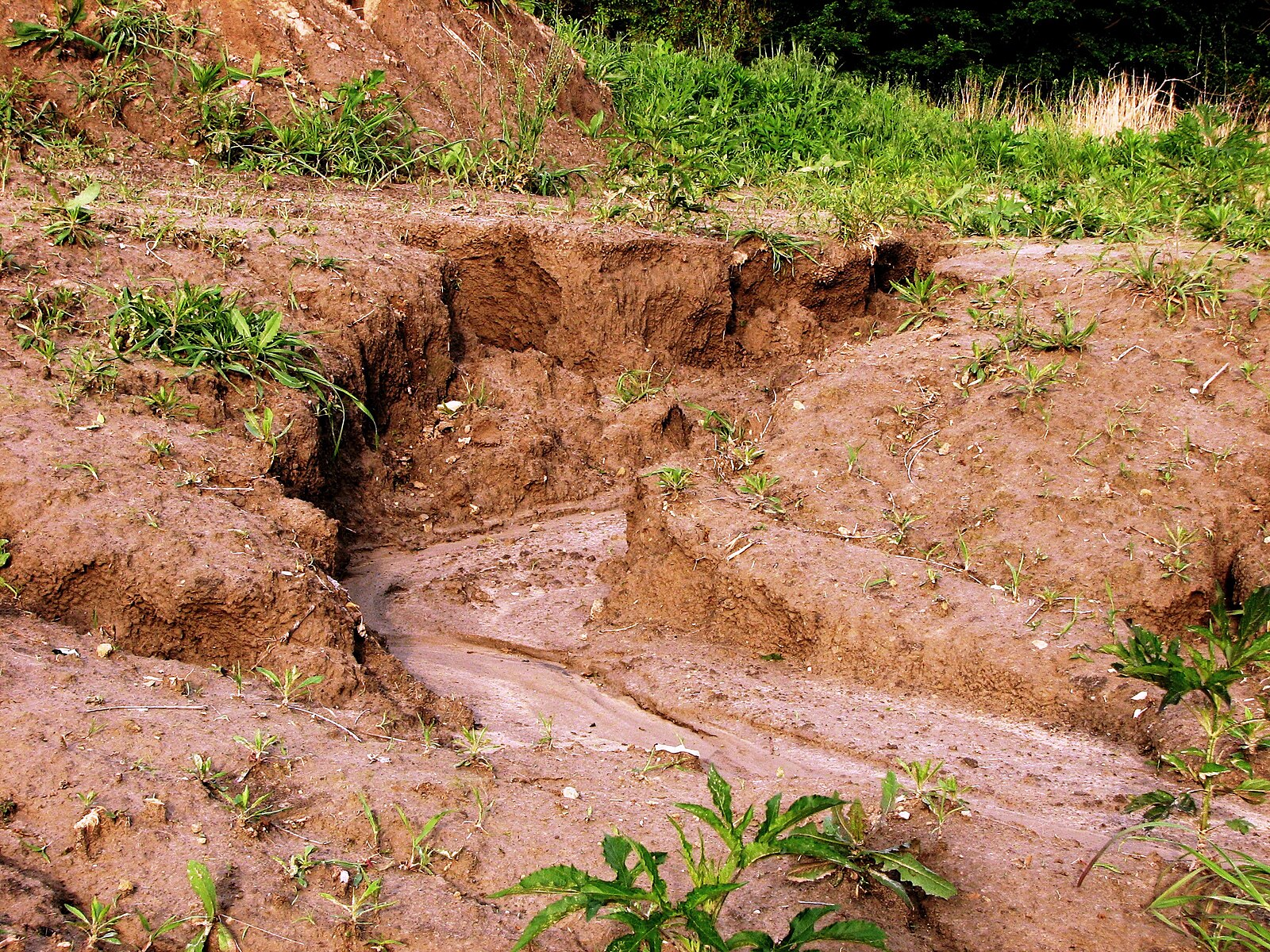IB Syllabus focus:
‘Outputs include decomposition heat, erosion, leaching and plant uptake; persistent losses alter components and can degrade productive soils.’
Soils are fundamental to ecosystems, yet they are vulnerable to outputs and degradation. Understanding how soils lose nutrients, structure, and productivity is crucial for sustainable land management.
Outputs from Soils
Decomposition Heat
Organic matter in soils undergoes decomposition, a biological process driven by microorganisms breaking down dead biomass.
Decomposition: The breakdown of organic material into simpler compounds by biological and chemical processes.
As microorganisms metabolise organic matter, they release energy in the form of heat. While this heat influences soil temperature and microbial activity, it represents an output of energy rather than material.
Erosion
Erosion is the physical removal of soil particles by wind, water, or human activity.
Erosion: The displacement of the upper soil layer through agents such as water, wind, or tillage.
Key factors that accelerate erosion include:
Removal of vegetation cover, which normally stabilises soil.
Intense rainfall leading to surface runoff.
Over-cultivation and poor tillage practices.
Soil erosion leads to the loss of fertile topsoil, which is the most nutrient-rich horizon, directly reducing agricultural productivity.
Leaching
Leaching is the downward movement of dissolved nutrients through the soil profile, often carried by percolating water.
Leaching: The removal of dissolved substances from soil by water moving downwards through the soil profile.
Nutrients like nitrates, potassium, and magnesium are particularly prone to leaching, especially in sandy soils with low water-holding capacity. This process decreases nutrient availability for plants and can also lead to contamination of groundwater.
Plant Uptake
Plants act as a continuous output pathway for soil nutrients. Through their roots, they extract water and essential minerals such as nitrogen, phosphorus, and potassium.
If plant biomass is repeatedly harvested without replenishing nutrients, the soil suffers progressive depletion, making long-term cultivation unsustainable.

Diagram showing rainfall and irrigation driving percolation, with water-soluble nutrients (e.g., nitrate) moving downward beyond the active root zone. Labels clearly indicate lateral and vertical water movement, the soil profile, and deep percolation, illustrating how leaching lowers fertility and risks groundwater contamination. Source.

A field example of gully erosion formed by concentrated runoff following heavy rain. Such channel formation removes organic-rich topsoil, exposes subsoil, and accelerates further degradation downslope via sediment delivery. Source.
Soil Degradation Risks
Persistent Losses of Soil Components
When outputs exceed natural replenishment, soils enter a state of degradation. Persistent nutrient and structural losses alter the balance of soil systems, undermining their productivity.
Key forms of degradation include:
Nutrient depletion: Loss of nitrogen, phosphorus, and potassium through leaching, erosion, and crop harvesting.
Loss of organic matter: Continuous decomposition without replacement reduces soil humus and weakens structure.
Compaction: Repeated trampling or heavy machinery compresses soil, reducing aeration and water infiltration.
Desertification and Loss of Productivity
In severe cases, persistent outputs contribute to desertification, the process by which fertile land becomes barren.
Desertification: Land degradation in arid, semi-arid, and dry sub-humid regions resulting from climatic variations and human activities.
This occurs when nutrient loss, erosion, and salinisation interact to reduce plant cover, exposing soil to further degradation cycles.
Feedback Loops in Soil Degradation
Soil degradation often accelerates through positive feedback loops:
Erosion removes topsoil → reduced fertility → poor plant growth → less protective cover → increased erosion.
Leaching depletes nutrients → weakened vegetation → greater susceptibility to erosion and compaction.
These self-reinforcing cycles can cause long-term declines in soil quality and ecosystem resilience.
Human Contributions to Soil Outputs
Agricultural Practices
Intensive agriculture can exacerbate natural soil outputs. Common risk factors include:
Overuse of chemical fertilisers leading to soil acidification and nutrient imbalance.
Monocultures reducing biodiversity and resilience to nutrient depletion.
Over-irrigation causing nutrient leaching and salinisation.
Deforestation and Land Use Change
Removing forests eliminates root structures that anchor soil and reduces litter inputs, both of which are critical for maintaining soil fertility. This accelerates erosion and nutrient loss.
Overgrazing
Excessive livestock grazing removes plant cover and compacts the soil through trampling, leading to reduced infiltration and increased erosion risk.
Natural Processes in Soil Loss
Weathering and Leaching Interactions
While weathering releases minerals into soils, persistent leaching can carry them away before plants absorb them. In humid tropical climates, this interaction often results in highly leached, nutrient-poor soils despite intense biological activity.
Climate Impacts
Climate influences the balance of soil outputs:
Heavy rainfall accelerates erosion and leaching.
Warmer conditions increase decomposition rates, leading to faster organic matter loss.
Prolonged droughts reduce plant cover, increasing susceptibility to wind erosion.
Managing Soil Outputs and Reducing Degradation Risks
Restoring Nutrient Balance
To counter persistent nutrient losses, sustainable practices include:
Applying organic manures and composts to replace nutrients.
Using cover crops to fix nitrogen and protect against erosion.
Practising crop rotation to prevent nutrient exhaustion.
Preventing Soil Loss
Management strategies aim to minimise soil erosion and compaction:
Terracing and contour ploughing to reduce runoff velocity.
Windbreaks and vegetative cover to shield soil from erosion.
Controlled grazing to maintain ground cover.
Monitoring and Early Intervention
Recognising early signs of soil degradation, such as declining yields, visible erosion, or reduced water infiltration, is essential. Immediate management action prevents irreversible damage.
FAQ
Soil texture plays a significant role in nutrient movement. Sandy soils, with large pores, allow water to drain quickly, increasing leaching risks.
In contrast, clay soils retain water and nutrients more effectively due to smaller pore spaces and higher cation-exchange capacity, reducing nutrient loss.
Loam soils, with a balanced mix of sand, silt, and clay, provide moderate resistance to leaching while maintaining good fertility.
Plant uptake removes nutrients and water from the soil, making it an output. However, it also drives ecosystem productivity.
When plant residues are returned through litter fall or root turnover, many nutrients are recycled back to the soil, offsetting the loss.
Thus, uptake is beneficial if nutrient cycling is maintained but unsustainable if harvesting continually removes biomass without replenishment.
Gully erosion develops when surface runoff concentrates into channels with sufficient force to cut into the soil profile.
Conditions that increase risk include:
Intense rainfall events in areas with poor vegetation cover.
Sloping land with little structural protection.
Soils with low cohesion, such as silty or sandy profiles.
Overgrazing and deforestation often accelerate these conditions, making gullies more likely to form.
Soil erosion carries sediments into rivers and lakes, increasing turbidity and disrupting aquatic habitats.
Leaching transfers dissolved nutrients, particularly nitrates, into groundwater or surface water. This can trigger eutrophication, leading to algal blooms and oxygen depletion.
Both processes demonstrate how soil degradation has far-reaching impacts on freshwater quality and ecosystem stability.
During decomposition, microorganisms release energy as heat while breaking down organic matter. This heat cannot be recaptured by the soil system for biological use.
Unlike stored nutrients or organic matter, which remain available, heat energy dissipates into the environment.
As a result, it represents a permanent output from the soil system rather than a resource that can be recycled internally.
Practice Questions
Question 1 (2 marks)
Define leaching and explain how it can act as an output from soil systems.
Mark Scheme
1 mark for correct definition of leaching: the downward removal of dissolved substances from soil by water percolation.
1 mark for explaining how this represents an output of nutrients/minerals from the soil system, reducing their availability for plants.
Question 2 (5 marks)
Discuss two soil degradation risks that arise when outputs exceed natural replenishment in soil systems. Provide examples to support your answer.
Mark Scheme
Up to 2 marks for identifying and explaining the first risk (e.g., nutrient depletion, erosion, loss of organic matter, compaction, desertification).
Up to 2 marks for identifying and explaining the second risk.
1 mark for using relevant examples to illustrate the risks (e.g., gully erosion in farmland, nitrate leaching into groundwater, desertification in semi-arid regions).

